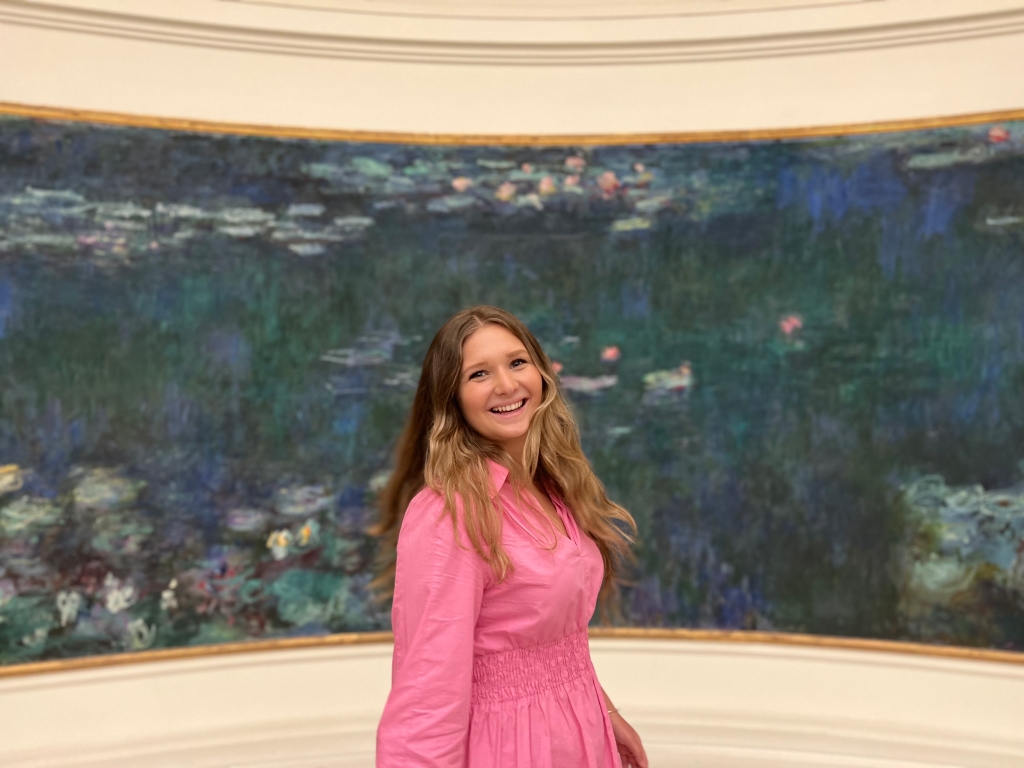
Isabel Brime is a junior majoring in Public Relations, Advertising, and Applied Communications (PRAAC) at the Florida International University’s Honors College. She hopes to pursue a career in travel or entertainment marketing. Coming from a Mexican background and culture, she was raised in a Spanish-speaking household along her two sisters. She loves to travel and add new adventures to her long list of hobbies: running, wakeboarding, paddle boarding, singing, writing, producing & editing videos, sewing and spending time with her family and friends.
Over Under Paris Project Line 4
“Attention à la marche en descendant du train” by Isabel Brime of Paris, France on July 2022

Introduction
Hop on the metro and get on line 4
If the metro’s too full, leave your bag on the floor
If you can’t balance well, then hold on tightly
Because if you don’t you’ll be swaying slightly
A month in Paris may sound like the perfect time to thoroughly get to know the city, but the truth is there is so much to discover and visit in Paris. Being away from home can be difficult, but if you learn to appreciate the beauty and culture, you will make a home away from home. Miami is very different than Paris, my home away from home, so it’s easy to go straight into comparing. Instead, they should both be admired on different pedestals and with different critiques. The public transportation system, for example, is not the best in Miami, however, Paris does a great job with its RATP metro line, bus, RER, and tram services. There are 14 lines and 308 stations, so it’s hard to visit them all, but line 4 was like my key to the city. Metro Line 4 goes from Porte de Clignancourt to Bagneux-Lucie Aubrac, making 29 stops across Paris. It took me to different parts of the city varying from a catacomb to a mall to a church. Whatever I wanted to see, Line 4 would take me there.
Étienne Marcel
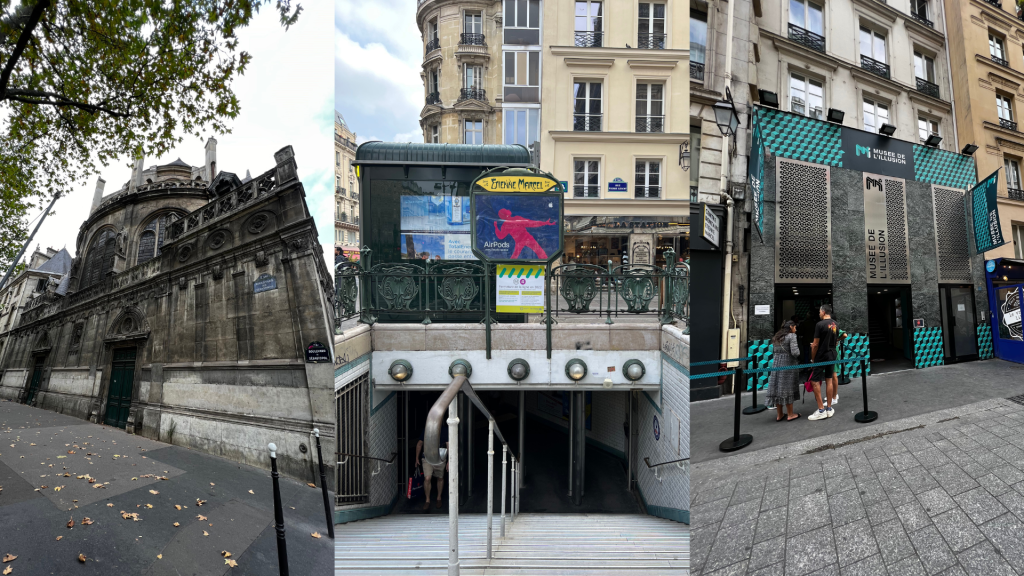
Hop off the doors when you reach Etienne Marcel’s,
Where you’ll find a big church and hear ringing bells
Between the first and second Arrondissements, you’ll find Saint Leu Saint Gilles
And a couple of garments sold for less
The first stop on the line takes you to Etienne Marcel, which is named after the Merchants of Paris’ provost, who was an important figure in the first Parisian revolution during the 100 Years War. This stop includes a strip of affordable restaurants and stores across a church. Etienne Marcel acted as the spokesperson of the third estate during the 1350s, so he represents the people of France, which I think is represented in this stop. Although you can find restaurants of all types and stores of different vibes, you can find affordable options all around. As you keep walking, you can find used clothing stores and skirt stands, but can also find a museum of illusions or boutique cosmetics stores. Whatever you want to look for, you can find. If you have a lower price range, you’ll be able to find it, and if you have a little extra bit to spend, then you can find stores or restaurants to spend it on as well. For example, a little walk over, you’ll be able to find Centre Pompidou., a modern art museum that has an expensive rooftop bar with an expansive panorama. Right around the corner of the metro, you can find L’escargot Montorgueil, a top-rated, pricey restaurant. However, it has a lunch special where you can get an entree and main dish for a price lower than the original main dish alone. You can also find small eateries nearby all around with cheap affordable food. The Saint-Leu Saint Gilles Church was built in 1235 but modified and rebuilt throughout time. In 1857, the work being done at the gothic church by Victor Baltard led to three dome chapels being destroyed. Much work has been done to it today and it even holds St Helena’s relics. This church used to be considered the one for the poorest of Paris, but today the area has been able to grow and the people flourish.
Les Halles
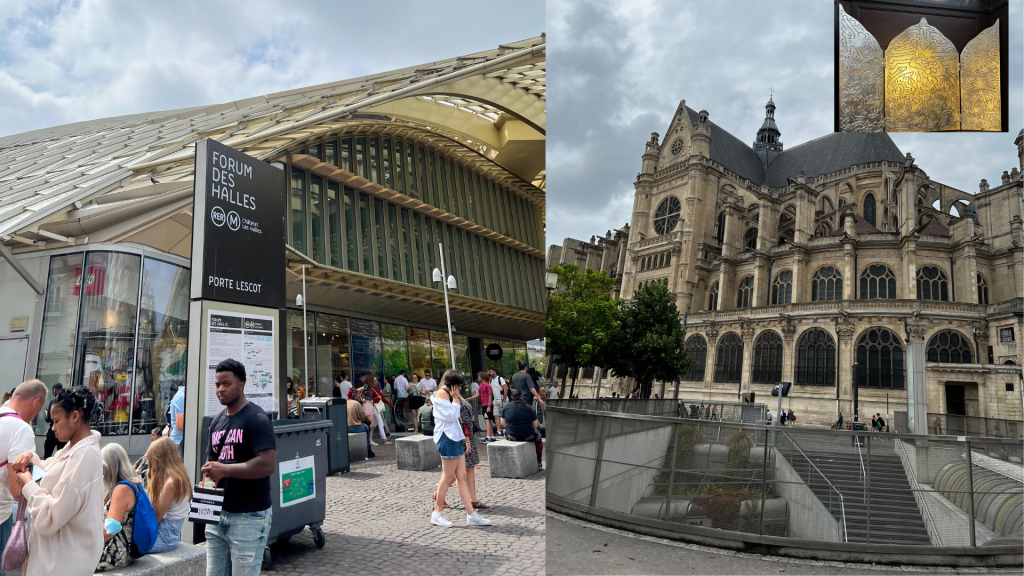
If you get back on line 4
Don’t get trapped in the door
Because this upcoming stop
I will have you shopping till you drop
The Les Halls is a forum that goes underground, full of fashion clothing stores, cafes, Monoprix, and gadget stores. You can find anything you need in this location. This big shopping mall attracts people ready to spend money, so people are waiting outside ready to greet them with music or dances, or other forms of entertainment in exchange for spare cash. This shopping mall has stores of all different brands, styles, and prices. If you’re lucky, you’ll be able to find lots of deals at Les(s) Halles. If shopping is not your thing, you can still enjoy the street performers around the forum. Some play instruments, while others dance. Whatever they are performing, people tend to always gather around and leave a couple of coins or even bills for their performance. One time I stopped at Les Halles and saw a large crowd of people watching about 5 men and women dancing in African outfits, while another played the Congo drums. These people brought a lively spirit to those visiting Les Halles. Speaking of spirits, you can find a spiritual place of worship right in front of Les Halles, Eglise Saint-Eustache! As soon as you walk in, you will most likely get greeted by the most famous organ player. This massive Catholic Church also has a lot of historical significance. Louis XIV received his first communion here and it also helped be the first to change the way that the AIDS/HIV pandemic was seen and treated. Saint-Eustache was one of the first to open its doors to those affected. They did acts of service to help, which was not common at the time, because people would shun them and other churches or religions would say it was a disease caused by their sinning. Because of their role in making the world recognize that those affected by HIV/aids still required basic human rights and attention, famous New York gay artist, who eventually passed away because of aids, Keith Haring, gifts a trifold image depiction to the Saint-Eustache Church. This stop is also surrounded by restaurants where you can kick back and enjoy a nice meal. At Les Halles, you will find H(all)es types of food to eat, music to hear, clothes to shop for, and people to see.
Châtelet
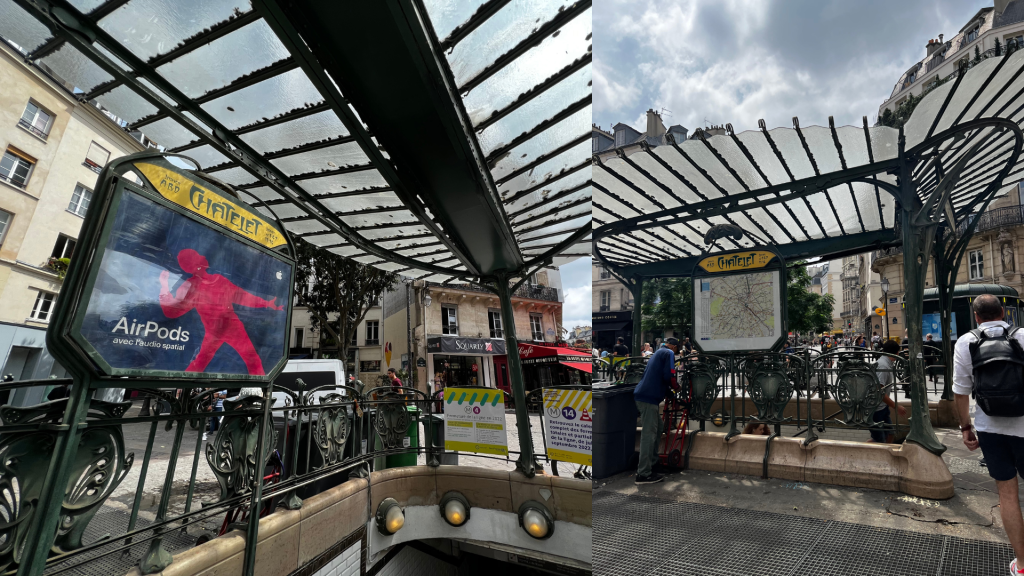
The next stop on this metro is like a connection
Busy people move and transfer in this section
People are on their way to their jobs and ready to work
You’ll have to be patient, please don’t be a jerk
Paris is a busy city with people who work and live there and also those who visit and leisure. The most important and touristy cities of Paris require a lot of workers, but the apartments close to them are very expensive, so most people live a bit further and commute. Châtelet is the center of the metro, so this is where a lot of connections and transfers take place. This metro stop has 5 different lines you can transfer to, so it is a huge underground station. It also has access to stops RER A, B, and D, which is a rail system that reaches beyond the city’s center. Because this stop is so large, it gets very busy, with people trying to get to their next destination and just passing you quickly. Here, people tend to be a bit less nice as they are trying to arrive at their destinations on time. It’s a transfer of people and metros and even cultures. You can find great diversity in this metro line because it helps connect different lines, where different people live and interact. There are lots of people at this stop. The majority is trying to get to work, home, or touring/there for leisure. However, you can also find people trying to immigrate to a better life. For most, Châtelet seems to be a stop, but not the destination. Most of the people in Châtelet are there to transfer. It’s like a hop-on-hop-off bus. For example, people are getting to work or to eat, or trying to migrate somewhere else. An Algerian guy was trying to get to Dunkirk or a similar place so that he can work without having to get on a plane or pass through strict immigration.
Cite

Hop back in again and let’s go to cite
Where an island is located in the center of the city
Notre Dame is currently being restored for further renovation.
Napoleon crowned himself emperor in this popular location
Ille de la Cite is a very touristy spot, as it has many popular locations across the area around this metro station. This little “island” floats on the Seine River, holding a couple of other important parts. On Cite, you can find Hotel Dieu, which is one of the oldest hospitals in Paris. For a long time, this hospital was the only place where the babies of Paris were born. A walk away, you also have Shakespeare and Co., a publishing company and literacy center for anglo writers that now sells new and used books in English. This bookstore is very popular and attracts long lines of people to enter. However, the most well-known site at Cite is Notre Dame de Paris. This gothic Cathedral is one of the most iconic pieces of architecture in the Paris skyline. The gargoyles in the front don’t just serve as decoration, they also act as protectors by serving and protecting the Church. Its flying buttresses are very important for the architectural structure but are also aesthetically beautiful. This Cathedral is mostly known for its incredible rose window stained glass. Unfortunately, in April 2019, a fire broke out and the roof and spine collapsed. To this day, it has been closed for restoration. This isn’t the only tragic accident the church has endured. During the French Revolution, the Revolutionists beheaded the kings in front of the church, trying to get rid of all signs of monarchy, not knowing that those kings were instead the Kings of Judea. At Notre Dame, Napoleon Bonaparte crowned himself emperor of the French, so this Church has historical significance in France’s history. Although I was not able to go on this trip, I was fortunate enough to have visited in 2017 and the windows and inside of Notre Dame are quite beautiful. This center stop is a great place to overlook the Seine River with the views of Notre Dame’s flying buttresses and exterior architecture.
Saint-Michel
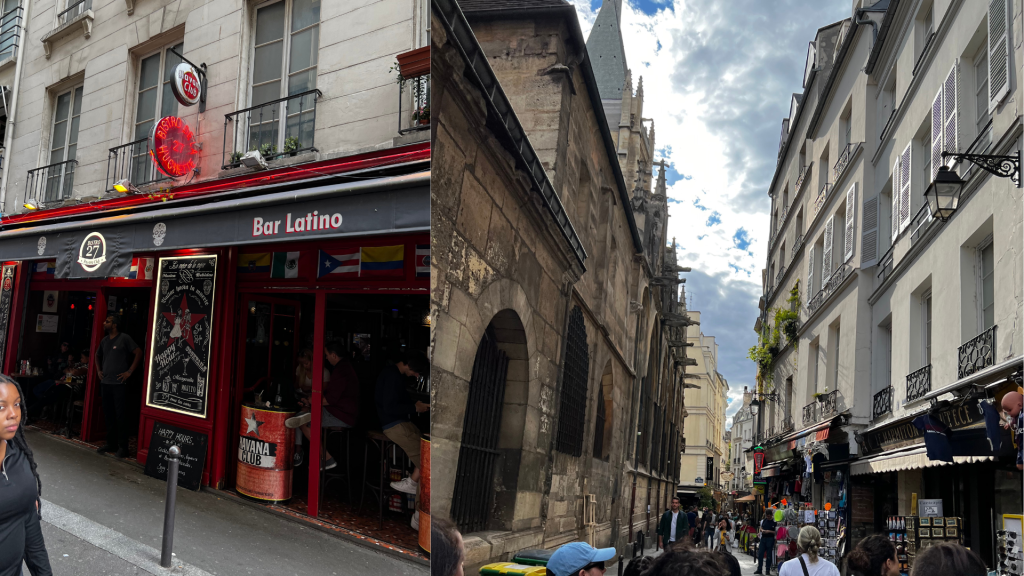
This next close stop might be the best one yet
If you want Latin music, you’re literally set
It’s a portal to student bars and eateries where Latin students meet
To exchange cultures and ideas, which is pretty neat!
This stop might quite literally be my favorite of all, being the stop I visited the most. The Saint Michel metro stop takes you to the heart of the Latin Quarter, right across the Seine River and Notre Dame de Paris Cathedrale. In the Latín Quarter, you can find Latino bars, Greek food, souvenir shops, candy stores, jazz clubs, churches, and more. The people who you could find here were the most welcoming and sweet. In the Latin Quarter, you could expect to find all sorts of people from different nationalities, varying from the Dominican Republic to Arabia to Italy, so the area is very attractive to students, especially of other cultures. This is one of the oldest districts in Paris, which is what shows us what medieval Paris used to look like. Originally, this area was known as the Latin 1uarter, because the students would move here to study and would only speak in Latin to each other to communicate. This area was a predominately Algerian student neighborhood that was famous for helping the state gain independence in 1968. These are the students who protested by picking up the cobblestone and throwing it saying, “Under the cobblestones, the beach.” The historical importance of this area is what makes the Latin Quarter so appealing today. Students from all around came to meet there and share the language, just like today this is a hotspot of students from all across the world. I was fortunate to have met students on vacations, locals, and even students on study abroad like me. This region has friendly workers, who are knowledgeable in many different languages and cultures and who make conversation with you in the language you prefer. If you can’t speak French, this is the best place to go and feel comfortable ordering in your language. In this sector, you can have fun in the bars, getting to listen to different genres of music from bachata to French pop. This melting pot of cultures reminds me of home. Eat’s the closest thing to Miami because it has similar music, vibes, and the same sharing of cultures that makes it unique.
Odéon
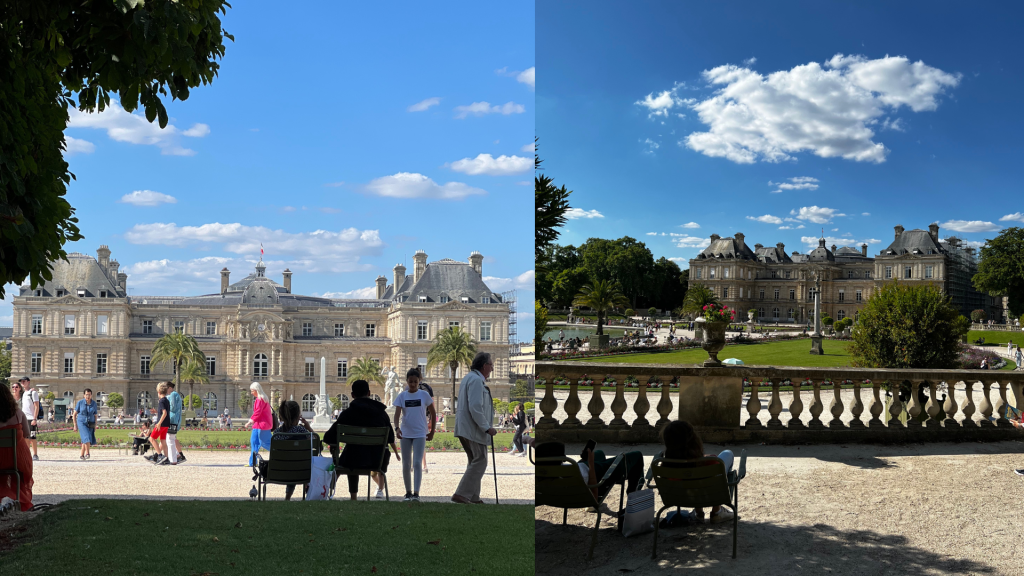
This next stop is also a popular student hotspot
Where they work on homework, sitting in the grass plot
Odeon leads you to Luxembourg Gardens and the palace
A place where beauty, elegance, and nature balance
The Jardin du Luxembourg is one of the first places we visited in Paris. We were greeted by wonderful patches of green, where we could sit down and picnic or do homework. The first time I came, I remember laying down after lunch and closing my eyes. I felt the sun on my face and a slight breeze. I could smell the champagne from the picnic-goers next to us and hear fading conversations from all over the park. It was a beautiful park that made me feel relaxed, so I came back just a couple of days later and decided to do my homework there. I never went inside the palace, but I learned that it belonged to Marie de Medici, because she did not want to continue to live in Louvre after her husband, Henry IV, was assassinated. She decided to move out and build the Palais du Luxembourg alongside its gardens. The architecture is inspired by her childhood home in Florence, Palazzo Pitti. Along the rest of the gardens, you can find little stands and tables selling crepes, ice creams, and more. In the next block, there is the Odeon Theatre situated on the left bank of the Seine River. It is one of the six national theaters in France, situated on the left bank. Today, Odeon Theatre still has showings of theatrical performances that you can watch at one of the oldest operating theatres in Europe. This stop resembles elegance with the Luxembourg Palace and the theatre, but it shows an embracing side of royalty, where all are welcome. The Luxembourg gardens invite anyone to come and sit on the grass and enjoy the beauty. The theatre opens its doors to welcome any who would like to watch.
Saint-Germain-des-Prés

If an artist experience you had planned,
In Saint-Germain-des-Prés you should land.
This area hosted writers, philosophers, and creators
But now they’re expensive restaurants with angry waiters
Saint Germain des Prés was a cafe sector where all creators would come and meet. Some of the people that met here regularly include Paul Veriene, Andre Duran, Oscar Wilde, Ernest Hemingway, and Simone Devobois. Two of the most famous cafes are Deux Maggots and Cafe le Flore. This spot was a culturally important place because it was where many writers and philosophers were inspired to create or where they spent all their time. Although these cafes were once good enough to eat daily or affordable enough for artists, today they are now made for tourists, raising their prices and lowering their service. Place de L’Institut is also located in the Saint German des Pres stop. When Louis XIV built the Academy of Sciences and Arts, he decided that he also wanted an institute of France to protect the French language. They make sure that you use the proper words correctly and not shorten them or say them wrong. The church located just behind the metro stop shows the original colors from the 19th century that were found on the walls and columns. When a little bit of the original pigment was found, they created a replica to make it look real. Outside on the weekends, they sometimes have an open-air market where they sell wooden trinkets, soaps, jewelry, and other fun stuff. Saint-Germain-des-Prés is a busy stop, where we see how culture and experience meet art and hard work. This stop has helped preserve, modify, and share the culture and art of France in a great way. The institute of France protects the language, ensuring that everything is well said and written throughout the different grammar rules. Its grand columns and gold-plated details show that France is large and important, so their language is important and must be kept. You don’t have to be religious to appreciate being able to see a restoration of what the inside of the gothic churches looked like so many years ago. Being able to take a look into the past is inspiring and this Church does a great job at opening its doors for us to observe. Although religion, might not be an important part of the French culture anymore, the architecture of different religious institutions, like this one, still shows culture and beauty that can be admired.
Montparnasse-Bienvenüe
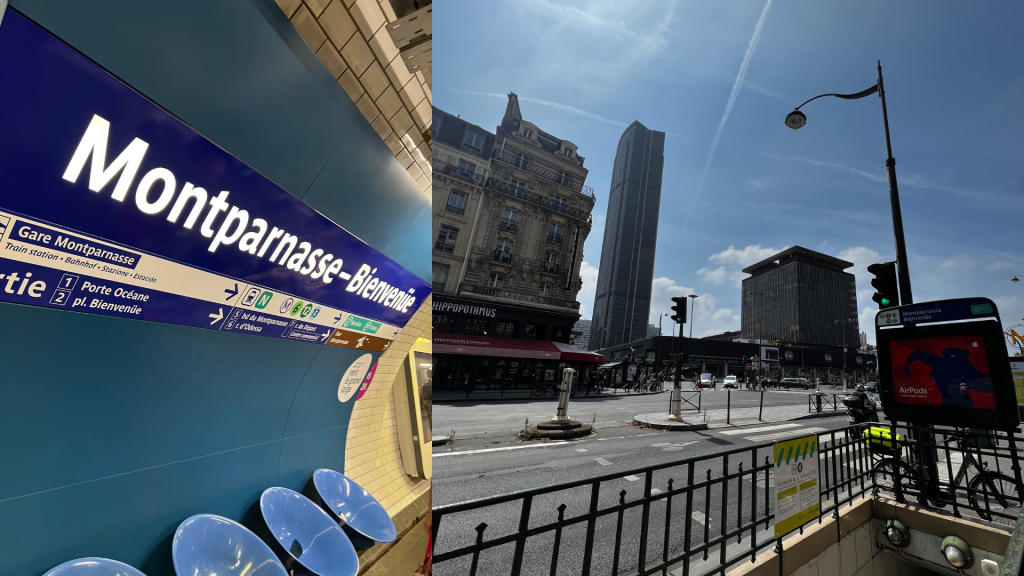
Hop on as we reach the end of the line
This next stop is one that sticks out on the skyline
We’ve been welcomed to the tallest skyscraper
Where we can find the mistakened caper
This stop is an interesting one because it is one of the most modern skyscrapers and the newest additions to the Parisian skyline. They created this building to test the waters, but it ended up backfiring. People were upset, and the idea of turning more of them into actual skyscrapers was quickly abandoned. Although Bienvenue sounds like it’s just welcoming you to Montparnasse, it’s important to note that it’s the name of a person. This man is very important to know in history, because it’s thanks to him that line 4 exists, and every line for that matter. He is a French civil engineer that organized the construction of the Parisian metro. Today he lies in Pere Lachaise, but we stop to thank him today for his help in making this transportation system possible. Some rumors say that the Bienvenu part was added last minute when naming the metro stops because they wanted to find a way to honor Fulgence Bienvenüe, the father of the Paris Metro. He was one of the most outstanding engineers in France and the big skyscraper want meant to also pay homage to him and his work. So, although it may stick out like a sore thumb, it was not just a silly project made to mess up the architecture of the whole city. I personally even think it was a nice touch. At first, the Eiffel Tower was first seen as an eyesore and not understood, but today it is celebrated and adored, I think that the Montparnasse Tower is a nice touch of modernity to add to Paris skyline. It’s not meant to disturb the peace or change the city. It’s meant to connect the past and the culture from yesterday with a touch of science and modernity of the future. Instead of viewing it as a fish out of the water, I see it as a little touch of today to show that Paris culture and architecture are here to stay, but they embrace modernity and the future.
Alésia
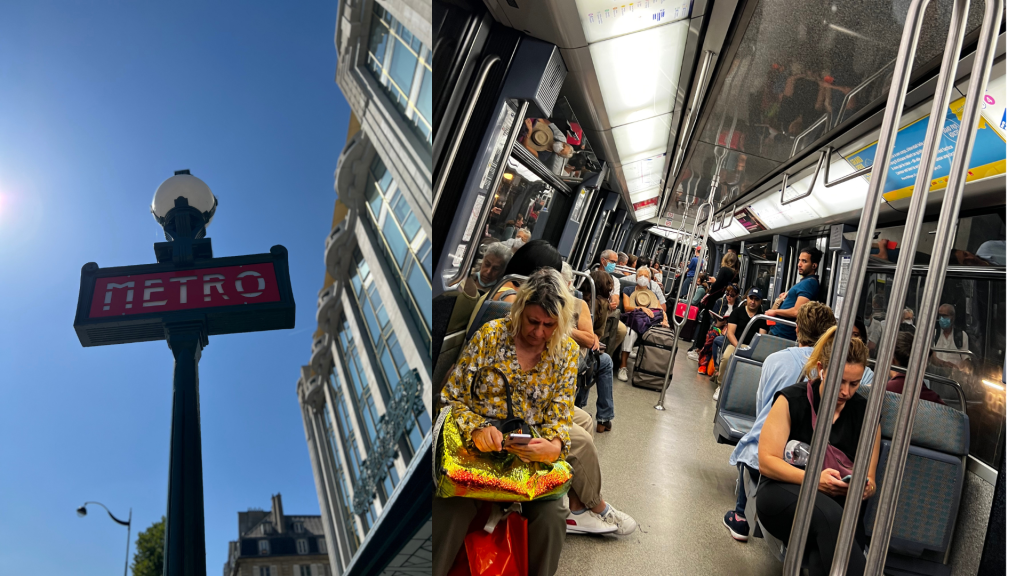
When you hop off the metro, you’re greeted by restaurants
Different options to eat and a couple of storefronts
It’s nicer than some and simpler than most
But this Metro stop is worth the boast
Alésia is one of the closest metros stops to the university with different food options. After spending a month eating hectic takeaway lunches or gulping down falafel sandwiches or kebabs, going to Alésia is a great refresher. It has friendly workers that are ready to recommend you different options on the menu. The area around this stop is quite calm normally, which is a bit of a juxtaposition based on what it was named after. Alésia was named after the Battle of Alésia between the Gauls and the Romans. The Gauls eventually surrendered, securing the Roman authority and power over the area. The name of this stop, although kind of ironic, is a bit like a sign of peace. To me, it shows that amid chaos, there can be peace. Alesia is normally a peaceful stop to pass, except sometimes it does get loud or full of people. This shows that not everything has to be so black and white. It doesn’t have to be a violent location to commemorate the war, it can be peaceful or just neutral, just like Alesia.
Porte d’Orléans
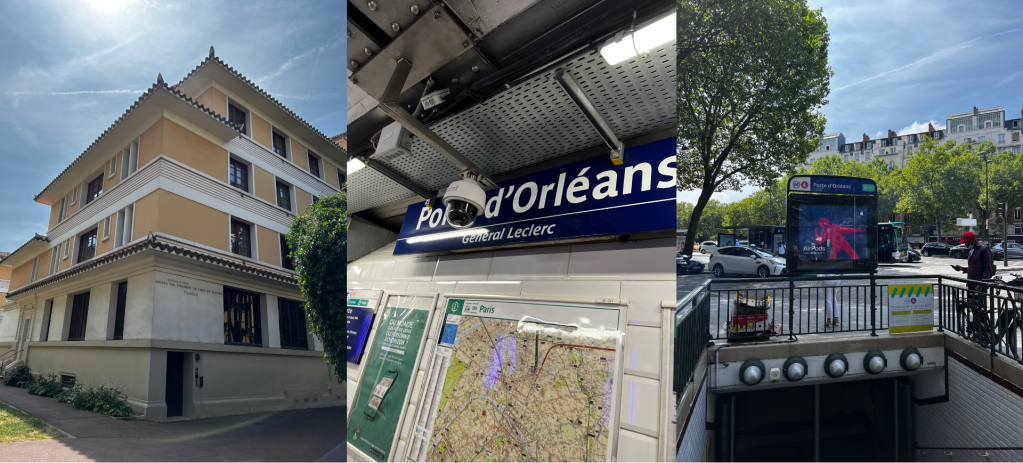
Hop on the metro to get to the last station
Porte d’Orleane is the final destination
This place means I’m home, I can go to the bathroom
Or at least that’s what reminded me of my room
Although Line 4 goes all the way to Bagneux, my trip ends at Porte d’Orleans. To remember what line to take to go home, I used the little trick of using “Bagneux” and using it like a pun by referring to it as the bathroom “Baño” in Spanish. When I come from a long day, I’m usually thinking of taking a shower, washing my hands, or going to the bathroom, so it’s a helpful trick. Porte d’Orleans is a place of confusion because, on one side, It feels like a safe zone where you know you are home and have like three restaurants you could go to. On the other hand, there were a lot of people who would sleep on the streets or sit asking for money. It was supposed to be a student area because Cite International Universitaire is located right off this stop and down until even after the next stop, but the majority of people who live there and commute in this area are older men and young adults in need of help. Across the university, there is a street of immigrants who sleep on the street with all of their belongings around them. However, it is also a nice area with student opportunities to connect. Bistro 27, just a five-minute walk from the metro, is very near to the exchange of RERs, so its good food attracts quite a couple of people. The best thing in this line stop is Cite Universitaire, La Maison des Etudiantes de la Sud Asie. It allowed for a place of sharing cultures, language, food, music, and good times. It was like a little home away from home. Porte d’Orelans helped me get closer to my school by sharing stories with other students and recommendations. We also were able to interact with them quite a couple of times, in the basement particularly.
References
anderstoodanderstood 13344 bronze badges, & user8690user8690. (1965, June 1). Why did Paris name a metro station and a street after étienne marcel? History Stack eh Exchange. Retrieved August 2, 2022, from https://history.stackexchange.com/questions/42695/why-did-paris-name-a-metro-station-and-a-street-after-%C3%89tienne-marcel
Bureau, P. C. and V. (n.d.). Odéon – Théâtre de l’Europe – Paris Tourist Office. en.parisinfo.com. Retrieved August 2, 2022, from https://en.parisinfo.com/paris-museum-monument/71656/Odeon-Theatre-de-l-Europe
Chaulin, C. (2021, January 13). Te urt était Etienne Marcel, chef de la Révolution Parisienne ? Geo.fr. Retrieved August 2, 2022, from https://www.geo.fr/histoire/qui-etait-etienne-marcel-chef-de-la-revolution-parisienne-202756
Church Saint-Leu-Saint-Gilles – monument in Paris. France. (n.d.). Retrieved August 2, 2022, from https://www.france-voyage.com/cities-towns/paris-29996/church-saint-leu-saint-gilles-18662.htm
Cuttle, J. (2018, January 17). Montparnasse Bienvenüe: The greatest mystery of the Parisian metro system explained. Culture Trip. Retrieved August 2, 2022, from https://theculturetrip.com/europe/france/paris/articles/montparnasse-bienvenue-the-greatest-mystery-of-the-parisian-metro-system-explained/ Encyclopædia Britannica, inc. (n.d.). Battle of alesia. Encyclopædia Britannica. Retrieved August 2, 2022, from https://www.britannica.com/event/Battle-of-Alesia-52-BCE